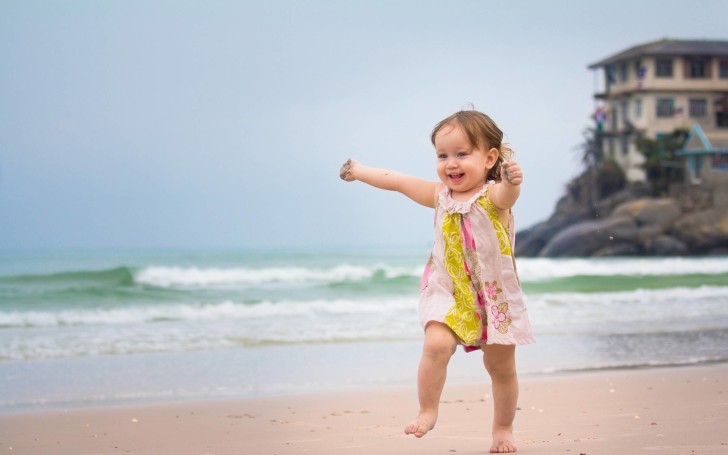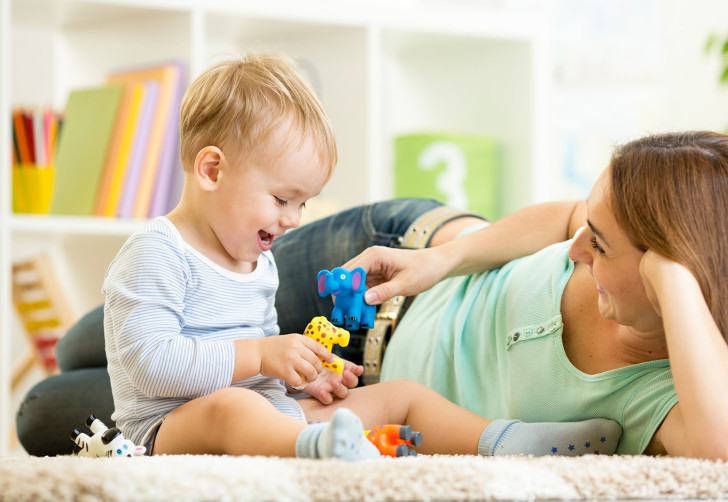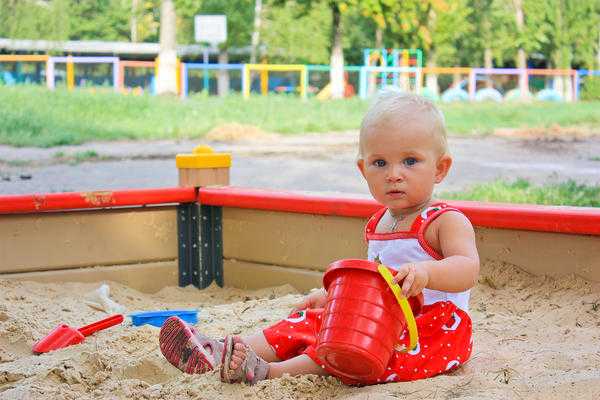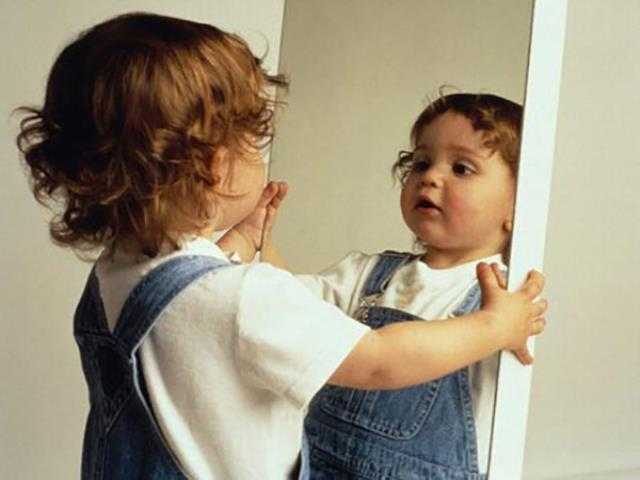The second year of a baby’s life is one of the most interesting periods of life. The baby still does not speak well enough, is still very attached to his mother and tries to spend as much time as possible with her. However, the baby begins to take an active interest in the world around him and wants to become more and more independent. What should children aged 1 year and 8 months be able to do? What parameters can be used to assess whether they are developing normally or whether it is necessary to seek advice from specialists?
Height and weight of a child at 1 year and 8 months
Correct and timely physical development The child is cared for by absolutely all parents, as it is the key to the baby’s health. What is considered normal height and weight at 1 year and 8 months? Height and weight values differ between boys and girls. Boys at this age should weigh on average 12 kg, girls - about 11.3 kg. Approximate height boys is 84 cm, girls – 82 cm.
Daily routine
From the first days of life, it is important to maintain a daily routine - both parents and the baby need this. What daily routine is acceptable for a child aged 1 year and 8 months? As a rule, a baby at the age of 1.5 years already has an established daily routine, in which about 12-13 hours are allocated to sleep.
Daytime naps are still necessary for a 1 year and 8 month old baby, and if the baby refuses to sleep during the day, it is better to continue good tradition and still come to an agreement with the babySleep at night is 10-11 hours, daytime sleep is 1-2 hours. Many children do not like to sleep during the day; it is quite difficult to calm them down and put them to bed. Dr. Komarovsky says that, despite the difficulties, it is better for parents to insist on a proper daily routine, including naps during the day, and try to create an environment for their child that is conducive to restful rest. Silence, drawn curtains - all this will help the child calm down and lie down. If he does not fall asleep or the sleep is short, he will still rest from active games and gain strength for further achievements.
What should a child be able to do?
At the age of more than 1.5 years, a healthy child is active, energetic and constantly busy exploring the world. As a rule, the baby already knows how to:
- Run well enough, standing steadily on your legs;
- keep your distance, watch the road and avoid obstacles while running;
- use stairs, going up steps without parental assistance and going down with little support;
- jump on two legs;
- play with the ball without missing or losing stability on your feet;
- open doors and furniture drawers.
 At one year and 8 months, the baby is already running confidently, he can keep himself busy and find interesting entertainment on his own
At one year and 8 months, the baby is already running confidently, he can keep himself busy and find interesting entertainment on his own Normal mental development
The first year of a child’s life is the most difficult for parents. The baby is completely dependent on their care and attention, and parents dream that the time will soon come when their child will become more and more independent. There is not long to wait - when the baby reaches the age of one and a half years, he begins to actively demand independence, shouting: “I myself!” and often becomes uncontrollable. Due to the fact that the ability to do everything on your own is not yet enough, parents should be patient and come to the rescue at the right time. At this age, the baby is learning, so it is important to show him the correct model for performing actions with your example and advice.
A child aged one year and eight months often shows anger and irritation, expressing them by screaming, crying and fighting. By behaving in this way, the baby tries to force all his desires to be fulfilled. You should not follow the lead and satisfy his every whim - you need to find an approach to the baby in a state of hysterics and develop a certain model of behavior.
Some parents simply do not pay attention, waiting until the baby calms down and only after that they try to talk to him, explain and console him. In any case, you shouldn’t get annoyed and yell at a naughty child. By conveying information in a calm tone and explaining that communicating through hysteria is wrong, you will achieve great results in education. It’s better to speak calmly and explain than to scream. In addition, whims are not always far-fetched - sometimes the baby is really tired, hungry or simply not feeling well.
Intellectual development of the baby
The baby is already interested not only in toys, but also to a greater extent in various objects around him. At the age of 1 year and 8 months, he hears music perfectly and, as a rule, begins to move to the beat.
The main task for the mother of a baby at this age is to develop in her daughter or son such skills as attentiveness, observation and imagination. It is useful to look at pictures and illustrations together, read poems and fairy tales. For active games, buy balls different colors and sizes. Also, children aged 1 year and 8 months are interested in rolling toys. The development of imagination can be promoted by playing with dolls with your child.
 In this age period the baby readily accepts the plot outline and is ready to play games that develop his imagination - for example, dolls, construction sets or thematic sets: “jungle”, “birds”, “railroad”
In this age period the baby readily accepts the plot outline and is ready to play games that develop his imagination - for example, dolls, construction sets or thematic sets: “jungle”, “birds”, “railroad” Proper nutrition
It is important to maintain a balanced diet for your child. Proper nutrition will contribute not only to physical, but also mental development crumbs. A well-designed diet should contain:
- Dairy products. You can cook porridge and soups with milk. As a daytime snack and in the evening before bed, you can feed your child yogurt, kefir or cottage cheese.
- Meat and fish products. Meat or fish should be present in the daily children's menu. For fish, preferably steamed pike perch or cod fillets. It is better to choose chicken or turkey as a meat dish, serving it to the child both in the form of meatballs or cutlets, and in chopped form. It's also better to steam it. You should not feed your child sausages, salami or smoked meats.
- Meat by-products. Preferably stewed. For example, you can stew the liver with sour cream, resulting in a tasty and satisfying dish.
- Cereals. Oatmeal, buckwheat or any other porridge should be the main dish of the baby’s morning or day. Cereals can not only diversify the menu, but will also bring undoubted benefits to the body.
- Vegetables and greens. Boiled or finely chopped vegetables will be an excellent dish for your baby. In addition, you can continue to feed your baby vegetables in the form of puree.
- Fruits. Pears, apples and any other available seasonal fruits will complement your daily diet well. You should be careful with fruits such as citrus fruits, kiwi and peaches, as they can be allergens.
- Bakery products. Do not overuse flour products. It is better to limit bread consumption - no more than 80 grams per day. White bread is preferable, as black bread can cause fermentation in the stomach, bloating and digestive problems.
In a series of articles about child development, the women's magazine NameWoman moves on to the difficult period of 1 year and 8 months.
Physical development of a child at 1 year and 8 months
The sleep problem, which usually occurs during the stage, continues into the next period. Some babies adjust and happily sleep about 13 hours a day, but for others this just doesn’t work out, and as a result, it’s difficult to even persuade them to just lie down on the bed.
For children, sleep is not an interesting activity; it is much more fun to tinker with toys or run around. However, parents must follow the “quiet hour” rule. Otherwise, the baby’s hyperactivity will result in an evening tantrum.
Let the child just lie down or at least sit in bed with his favorite toy, listen to quiet music or read his favorite book. Hug the baby, pet him. Perhaps he will relax and be able to fall asleep. In extreme cases, he will still be able to take a break from his active work.
In order to make hyperactive children a little calmer, some mothers, aged from about one year and seven to eight months to two years, turn to a pediatric osteopath for help for the first time. The work of an osteopath or an experienced pediatric chiropractor has a good effect on both the physical, emotional and even intellectual development of the child; massage sessions help improve health.
Social development of a child at 1 year and 8 months
The behavior of a child at 1 year and 8 months is not much different from the period of 1 year and 7 months. The child actively fights for his property, biting and using his fists. He jealously monitors his playing area, not allowing other kids to get close to him and his things. He senses the approach as a threat to his self.
The baby actively resists calls to do anything. He instantly becomes “deaf” when his parents send him to bed or take him out for a walk. After all, at this moment it is much more important for him to play with his favorite toys.
Sometimes behind children's whims there are real problems that cause discomfort to the baby. Perhaps he gets sick or feels hungry, or just wants to sleep, but he himself is not fully aware of his desires and needs, and cannot explain what is bothering him. Sensitive parents must understand the problem so as not to inadvertently aggravate it, but solve it as soon as possible.
Yes, you may have to take in more air into your lungs so as not to start screaming. But in this situation, a negative response can frighten the baby, leaving a trace of resentment on his subconscious level. If an adult is hungry and talks about it to his loved ones, and in response they begin to rain down angry curses on him, then they will receive nothing in return except aggression and anger. The situation is the same here. Only the baby explains his needs a little differently, because in words he still cannot identify the problem clearly and clearly.
Baby's physical development this month
By this time, each child typically sleeps about 13 hours a day. For some children this is not a problem and they are happy to go to bed in the morning or lunchtime. But there are still children who categorically protest against daytime sleep and putting them to bed when the sun is shining outside is not realistic. Usually, children at this age can get by with a short nap or at least a rest in the middle of the day; it is better, of course, if he sleeps for at least a couple of hours. Only hyperactive kids can run around the apartment from dusk to dawn without sleep or rest, without feeling tired at all. If your baby can be classified as such a category of children, then try to create all the conditions for him, if not for sleep, then at least for rest. Dimmed light in the room, a book of fairy tales that you usually read before bed, calm music, in general, everything that will make the atmosphere in the house conducive not to activity, but to sleep, will help you with this. And if the child never falls asleep, he will still get a break from noisy games and constant running around. This will help him regain his strength for further marathons.
Peculiarities of child development in society during this period
Children of this age, sometimes even younger children, just like “unbearable two-year-olds,” tend to experience bouts of anger. If you don't give them what they want at the moment, they may start to tantrum, scream, cry, bite, etc. At this time, your baby already knows perfectly well what she likes and what she doesn’t. For example, she doesn’t like the fact that she has to throw away her favorite toy and go to bed, although she still wants to play.
Also, the baby may begin to ignore your “no” to some of his actions, especially if it contradicts what he has in mind. At this age, children cannot yet verbally express everything that does not suit them, so a completely normal reaction of a child to something negative, in his opinion, will be a characteristic cry, whims, anger, tears, and the like. This behavior can indicate many things. This may indicate that your baby is hungry, or tired, or in pain, or simply bored. You can prevent such outbursts of rage by trying to predict the possible cause: feed the baby well before the walk, give him the opportunity to sleep, etc. As a rule, this happens up to three to four years. By this age, children usually have mastered sufficient vocabulary to express their emotions and feelings, and also master self-control. In the meantime, be patient and remember that this will soon pass, do not try to extinguish children’s anger with your anger. Count to 10, take a deep breath - and calm down.
Peculiarities intellectual development baby at this age.
At this stage of the baby’s life, he already understands himself as an individual. Some children at this age can say their name and recognize their reflection in the mirror. In addition, he actively repeats after you everything you do. He can copy your movements, for example, when you are cleaning the house, he tries to help you, and it does not matter at all what exactly you are doing at the moment. Whether you are preparing dinner, or collecting scattered things around the house, or folding laundry - the baby wants to be useful in everything. It’s clear that your child’s attempts to help you slow down your work, but you shouldn’t stop his attempts. On the contrary, involve him in work, turning things into a kind of game. For example, ask your baby to collect all the red things from the floor or take something to a table, chair, etc. If you don’t do this, then very soon you will have to ask, or even force him to clean up after himself.
I found information on what a child should be able to know at 1.8 months. In my opinion, this is not real. Are there any children who do all this?
The first thing that parents are usually primarily interested in is speech development:
1. On average, at the ages of 1 year and 8 months, girls begin to speak actively; boys, as a rule, begin to speak a little later, on average by two years. Active speech is the use in speech of simple constructions consisting of several words, the use of various parts of speech - verbs, nouns, prepositions... (adjectives - a little later). In short, the child not only speaks in individual words, but formulates phrases such as “I won’t go swimming,” “Daddy has come,” “Give it to me, I need it!”
The child must understand the meaning of the phrase and, at the request of an adult, bring even an object that is not in his field of vision.
2. By the age of two, any child is able to distinguish not only the colors of the main spectrum, but also halftones and shades. But if this happens in three years, no one will die.
3. Distinguish objects by size and shape. Big-small. Round - square, triangular (this means visually distinguishing shapes - for example, correctly assembling a toy insert with geometric shapes). But in principle, at two years old, any child can know the terminology - the names of figures, and not only planar ones - square, circle, rhombus, triangle, etc., but also volumetric ones, such as a ball, cube, pyramid. Knowledge of terminology already depends on the pedagogical capabilities of parents))
4. Development of play and object-based activities: the child must be able to play or perform actions according to a model: feed a doll, comb his hair (make movements), use a spoon, kick a soccer ball, put a car in the garage, etc.
5. Emotional development. In 1.8 - appropriate reactions to positive and negative assessments of an adult; the development of various emotions and feelings - joy, aggression, sadness... dissatisfaction or even anger in case of failure - these are normal and necessary things. Some children at this age already have a sense of humor.
6. At this age, girls and many boys are able to completely abandon diapers. And in any case, a child at 1.8 should be able to use the potty independently.
7. Eat independently, put on a hat, scarf, take off clothes (tights), put toys away.
8. Be interested in books, curious objects, react to music according to its character, be interested in cartoons, computers and other fascinating and educational things.
9. Runs, jumps, goes down and up the stairs. Plays ball. Rolling down the hill. Fiddling around in the sandbox.
10. At two years old, a child who has been taught reading, mathematics, etc. CAN (but should not)) recognize individual words written on cards, accurately show the named number of dots within 10-12. Recognize the objects depicted, know the names of animals, birds, trees, flowers.
13. Orientate yourself in space - up-down, far-close, high-low.
14. Visually identify identical items(find a pair)
15. Enjoy playing with water, paints, crayons, small objects such as beads, buttons (anything related to fine motor skills).
16. Must be able to occupy himself independently for some time - about 15 minutes
What should a baby be able to do? At 1 year and eight months, a child can perform two actions at the same time, and he may already begin to develop a crisis of a 2-year-old child.
Physical development of a child at 1 year and 8 months
A child at 20 months already has good command of his musculoskeletal system, stumbles and falls less and less often, moves with more self-confidence. Besides, he is able to perform two actions simultaneously- for example, walk forward and pull a toy behind you on a string.
Now he can not only roll the ball in one direction with his feet. The baby is mastering a new ability is to throw it with both hands from the head. Although sometimes he treacherously slips out of the palms squeezing him, it is difficult to deny that a real athlete has settled in your house.
A 1 year and 8 month old baby is very active, he can’t sit still for a single minute: he runs, dances, climbs onto a chair, and even... jumps! After months of persistent attempts to overcome gravity, the time has finally come to skim the cream: you need to bend your legs, concentrate for a minute and “hop!” - The baby is already in the air. This is a wonderful experience for him.
- Support your child's physical development through joint outdoor games. Jump like kangaroos or little bunnies. This kind of gymnastics has a great effect on the development of so-called gross motor skills, that is, skills associated with the work of the whole body.
- Ask your child to help you carry out household activities: press a door handle, turn the pages of a book, put a pan on a shelf... This kind of exercise allows you to improve the coordination of hand movements.
- Buy some plasticine for your child. Modeling, kneading, etc. develops manual dexterity.
- Bring your child to the sandbox. He will be able to make sand people, play with a shovel and rake, etc. - this is also great exercise.

Height and weight at 1 year and 8 months
- Boys on average they have a weight of 12.1 kg and a height of 83.9 cm.
- Girls- on average have a weight of 11.4 kg, height of 82.2 cm.
Emotional development of a child at 1 year and 8 months
Your baby entered, probably some time ago, into the period of rebellion of a two-year-old child. If this is so, you couldn’t help but notice it: every proposal you make is met with a contemptuous refusal.
A baby may, for example, tightly clenching his lips, refuse to eat dishes that he does not like, protest loudly when getting dressed in the morning, and scream to accompany his reluctance to wash his hair.

Despite resistance, a twenty-month-old child can be persuaded during daily rituals - at this age, although he likes to resist, he easily goes along with it and easily forgets about his previous whims. The baby, although reluctantly, will obey your insistence, but only if he sees some benefit in this. During the game, he easily allows himself to be persuaded to perform even unpleasant duties, and reacts to shouting and an angry tone by continuing to persist.
Child at 1 year and 8 months still prefers to play with adults. Left in the company of children, he plays next to them rather than with them. The stage of the so-called parallel game will take place approximately in the middle of the third year of life.
- Keep your nerves in check. Symptoms of childhood rebellion should be accepted with calm, but do not give up persistence when you demand that your requests be fulfilled. Decisiveness – best way behavior when communicating with a little rebel.
- Allow your child to make his own decisions in some matters., which you can accept and approve . Thanks to your small concessions, the child will feel independent and independent, and his emerging self-confidence will help him in the very near future in the life of a preschooler and student.
Intellectual development of a child at 1 year and 8 months
Child at 20 months already knows about 50 words and begins to slowly connect them in successive rows, for example, “mom – read – to me.” His speech becomes more and more understandable to others, although, of course, you cannot yet refuse the function of a voluntary translator.
Does your baby like to name everything that his curious eyes see (pets, furniture, objects in pictures that appear during walks of people and animals)? Great! This is a sign that his vocabulary is rapidly expanding.
Thanks to excellent observation skills, your child can see changes that are invisible to your eyes - for example, in the position of a book on the table or a brush on a shelf next to the mirror.
The baby now spends long minutes in front of the mirror, looking at his reflection with passion. At approximately 20 months of age the child begins to recognize his reflection in the mirror(he previously perceived him as a different child) and notes changes in his own appearance - for example, the hair pinned up on the top of his head. To reach the elastic band that collects the curls, the baby points his hand towards the head, and not towards the mirror, as was the case before.

Another important skill for a child is ability to count to two– some bright children can even repeat the sequence of numbers from one to five. This does not mean that a baby at this age already understands what the number two means. Understanding of such abstract concepts will come only after the second birthday.
- Don't give up reading. During this period, it may be quite difficult for the baby to concentrate on an open book or the images in it. However, don't give up. You can read to him during those periods of time when there is no opportunity to run - for example, while swimming or driving a car.



